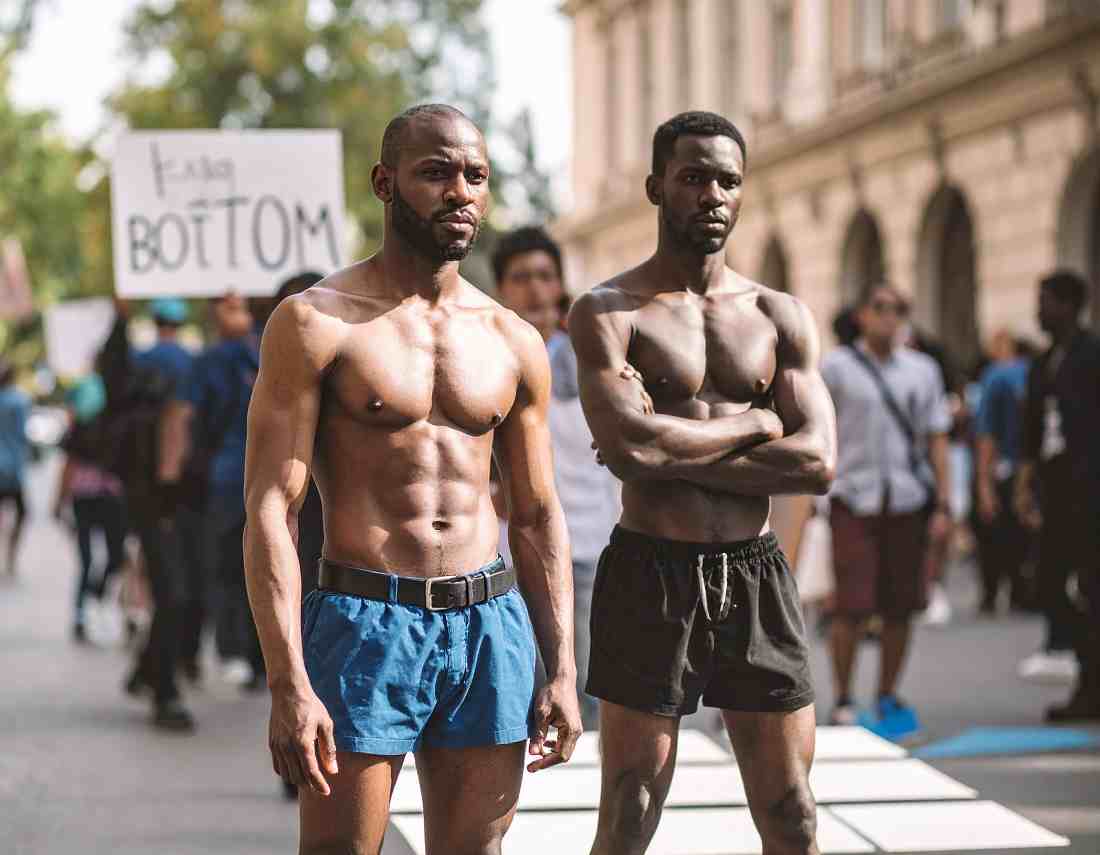By Daniel Nkado.

In queer dating and relationships, labels like top and bottom help people communicate what they enjoy. But when these terms solidify into permanent identities—dictating what someone “should” or “must” do—they can create unhealthy pressures that harm mental health, intimacy, and overall well-being.
This phenomenon, known as role rigidity, limits genuine exploration of queer desire and imposes gender-like attributes and stereotypes onto ordinary sexual preferences—the “gendering of sexual roles.“
The Politics of Sex Roles
Sexual roles in queer male culture — top, bottom, versatile — may look like simple bedroom labels, but research shows they operate as much more. These terms function as social identities, shaping how men think about masculinity, power, desirability, and even their own bodies (Moskowitz & Roloff, 2017)5.
Studies consistently find that sexual roles align with societal perceptions of behaviour, gender expression, body image, and even how men read each other’s faces. At the same time, studies also found that men are far more fluid in real life than the labels suggest, shifting roles across partners, contexts, and life stages (Wei & Raymond, 2011)9.
This shows that the strict adherence to role labels, while actual behaviour may be different, is driven more by power and status rather than actual pleasure.

Here are eight ways strict top/bottom roles quietly harm gay and bisexual men — and why embracing fluidity leads to healthier, fuller sex and relationships.
1. Increased Mental Health Strain
Gay and bisexual men already face higher rates of anxiety, depression, and psychological distress due to minority stress—the cumulative impact of stigma, discrimination, and internalised shame (Mereish and Poteat, 2015)4.
When sexual roles become rigid, they introduce additional pressure:
- Tops may feel they always have to be dominant or assertive, which increases constant self-monitoring/hypervigilance, lying and other compensatory behaviours.
- Bottoms may feel inadequate (feeling like a “failed man”) due to rigid masculinity ideals. This causes tension between their sexual role and self-image.
- Those who do not fit neatly into either role may experience shame or confusion.
Studies on queer mental health confirm that rigid sexual expectations intensify internal stress and reduce psychological well-being (Shaikh et al., 2024)6.
2. Reduced Intimacy and Emotional Connection
When partners are attached to fixed roles—“I always top,” “I never bottom”—they can end up performing a script instead of listening to their own or each other’s needs.
Rigid role expectations can:
- Make people feel they must act a certain way, rather than express what they genuinely want.
- Shut down experimentation and curiosity (“If I try X, people will think I’m really Y”).
- Limit emotional vulnerability, because being vulnerable can feel incompatible with a rigid idea of being a “real top” or “desirable bottom.”
True intimacy usually requires flexibility, negotiation, and mutual vulnerability. When roles are treated as fixed, relationships can start to feel stagnant—not because partners are incompatible, but because they feel locked into predictable patterns that leave little room for growth (Dangerfield et al., 20182; Brilmyer, 2024)1.
Research on gay male sexual dynamics shows that versatility—switching or exploring roles—enhances communication, equality, and relationship satisfaction.
3. Anxiety and Fear of Judgement
Once a role becomes a status badge, some gay men stop exploring and start protecting their reputation. Anxiety replaces desire.
- A self-identified “total top” who wants to bottom may fear being seen as less masculine or less desirable.
- A bottom who wants to top may worry they will be mocked, rejected, or not taken seriously.
- A versatile man may feel pressured to “pick a side” to be legible on apps and in dating culture.
This fear of judgement leads to secrecy, anxiety, and avoidance—undermining the honest communication needed for good sex and healthy relationships (Tskhay & Rule, 20138; Winder, 2023)10.

4. Unbalanced Power Dynamics in Relationships
Rigid “top” and “bottom” identities often turn regular sexual preferences into a hierarchy of power:
- Tops are framed as dominant, active, and in control.
- Bottoms are framed as passive, yielding, or less powerful.
Research shows that when roles are treated as fixed identities, this hierarchy can spill beyond the bedroom into everyday relationship dynamics (Dangerfield et al., 2018)2.
For example:
- Tops may feel pressure to always initiate, lead, and “take charge,” which can be exhausting and make it harder to ask for care or vulnerability.
- Bottoms may feel they have less say in pace, positions, or safer-sex decisions, especially if they’re cast as the more “needy” or replaceable partner (Zhou, 2023)11.
Over time, these patterns can normalise an imbalance where one partner’s needs are centred, and the other’s are quietly sidelined.
5. Role Gatekeeping and Shaming
In many queer spaces, role labels are policed through shaming and gatekeeping:
- Masculine tops who want to bottom may be told they’re “ruining” their desirability.
- Bottoms who express interest in topping can be mocked as “doing too much” or “not knowing their place.”
- Versatile men may be dismissed as “being confused,” “messy,” or “not serious.”
This behaviour is not harmless banter. Studies of online and community discourse show how bottom-shaming and role policing reinforce narrow ideas of masculinity and create hierarchies within gay communities (Winder, 202310; Zhou, 2023)11.
The result:
Increased internalised stigma and shame, less sexual exploration, and weaker solidarity in communities—especially for those already marginalised by race, body type, gender expression, or HIV status.
6. Lying, Performance and Dishonesty About True Desires
Treating sexual roles as fixed identities can create role dissonance—a mismatch between a man’s ideal role and his actual behaviour.
When the social cost of stepping outside your assigned role feels too high, many men cope by performing rather than expressing what they actually want.
This can look like:
- Saying you’re a “strict top” or “strict bottom” on apps even if you’re curious about other roles.
- Going along with sex just to “prove” your role, not out of genuine desire.
- Avoiding conversations about versatility because it might “damage your brand.”
This kind of role performance can:
- Lead to sex that feels disconnected or unsatisfying.
- Undermine trust, because partners cannot rely on each other’s words and boundaries.
- Intensify internalised shame when men feel they are living a double life—private desires vs. public identity (Newcomb & Mustanski, 2010; Dangerfield et al., 2018)2.
Over time, constantly acting a role instead of inhabiting your real desires can make you feel less at home in your own sexuality.

7. Fuels Many Harmful Behaviours in Sexual Encounters
Role rigidity doesn’t just limit intimacy—it can fuel harmful and coercive patterns in gay sexual culture.
Community reports and qualitative research on sexual positioning and masculinity describe behaviours such as:
- “Hole checking” – inspecting a partner’s body to “verify” whether they have bottomed before, reinforcing stigma around bottoming.
- “Test topping” – topping without genuine desire just to test whether a partner is “really” a top.
- “Phantom top-chasing” – refusing partners who admit to bottoming, searching for an “exclusive top” ideal.
- “Revenge topping/bottoming” – switching roles with a new partner to retaliate against a current or past partner.
- “Role defending” – denying or minimising a role-switch (for example, blaming alcohol or pressure) to protect a fragile identity.
When men fear their role reputation could be “ruined,” some resort to coercive tactics after sex—
- pressuring partners not to disclose what happened
- cutting them off to control the story, or
- using threats to protect reputation.
While research on these specific dynamics is still limited, broader work on sexual positioning, power, and consent among men who have sex with men shows how unequal role dynamics can increase the risk of boundary violations and unsafe sex[4].

8. Community-Level Impact
At the community level, role rigidity reinforces stereotypes that don’t match the real-life diversity of queer encounters.
- Tops are expected to avoid other tops.
- Bottoms avoid bottoms.
- Versatile men get dismissed as “confusing” or “not serious.”
Yet multiple studies show that many gay and bisexual men are functionally versatile, even if they identify with a primary role (Lyons et al., 20113; Tieu et al., 2013)7.
This mismatch between labels and behaviour means:
- People may reject potentially great matches based on assumptions about roles.
- The dating pool feels smaller than it already is.
- Loneliness and frustration increase as men compete for a narrow, often phantom, ideal (“masculine total top”) rather than exploring other compatibilities (Zhou, 2023)11.
Rigid labels also discourage self-discovery. Men who might enjoy multiple roles can get stuck in one identity for years, making the community feel imbalanced and less open to difference.
How fluidity helps
Sexual fluidity recognises that desires, roles, and preferences can shift across time, partners, and situations. Research on sexual roles and behaviour shows that:
- Many men who identify as tops or bottoms still switch roles with some partners or across their lives
- Versatility and flexible role negotiation are linked to better communication, mutual satisfaction, and sometimes lower relationship conflict[3, 7, 11].
Embracing fluidity can:
- Increase pleasure by giving people more options to fully explore their desires.
- Reduce anxiety and performance pressure tied to maintaining a rigid identity.
- Deepen intimacy by normalising honest conversations about desire.
- Expand compatibility and make the dating pool feel larger, not smaller.
- Reduce shame and stigma tied to bottoming, topping, or switching roles.
- Dismantle crooked power dynamics attached to sex roles (role politics).
Fluidity does not mean everyone has to be versatile. It simply means that roles should be guided by desire and consent, not enforced by fear, status, or stereotype.
Versatility, safety, and health
Sexual roles are tied to HIV/STI risk and mental health outcomes, and avoiding open conversations about roles and protection can undermine prevention and treatment. In contrast, clear, shame-free communication about roles, desires, and safety allows partners to coordinate safer and more-satisfying sexual practices.
Moving toward healthier roles and relationships
To move toward healthier sexual and relationship dynamics, gay and bisexual men should:
- Be honest about desires and boundaries. It’s okay if your preferences don’t match your public label.
- Normalise experimentation without pressure. Trying something else doesn’t mean your identity is cancelled or fake.
- Challenge stereotypes. Question role-based assumptions that equate masculinity with topping and weakness with bottoming.
- Soften extreme labels. Instead of “total top” or “dom top,” consider language like “mostly top but open” or “top-leaning versatile.”
- Seek LGBTQ-affirming support. Therapy or peer support grounded in minority stress and sexual health research can help untangle shame from desire [4, 6].
Rigid top and bottom roles are not just about what happens in bed—they shape how people see themselves and each other. Letting go of role rigidity and embracing more flexible, honest ways of relating with each other can reduce stigma, protect mental health, and create more genuine relationships.
The true goal of flexibility is not to get everyone to start switching roles, but to allow the freedom to be authentic, whether that means being a lifelong top, a versatile bottom, or something else entirely. What matters is that you are not performing a role out of external or internal pressures.
Daniel Nkado is a Nigerian writer and author, best known as the founder of DNB Stories Africa, a digital platform covering Black stories, lifestyle, and queer culture.
References
- Brilmyer, S. P. (2024). Queer Rigidity: Habit and the Limits of the Performativity Thesis. Critical Inquiry, 50(4), 610–639. https://doi.org/10.1086/730351
- Dangerfield, D. T., Smith, L. R., Williams, J., Unger, J., & Bluthenthal, R. (2016). Sexual Positioning Among Men Who Have Sex With Men: A Narrative Review. Archives of Sexual Behaviour, 46(4), 869–884. https://doi.org/10.1007/s10508-016-0738-y
- Lyons, A., Pitts, M., Smith, G., Grierson, J., Smith, A., McNally, S., & Couch, M. (2011). Versatility and HIV Vulnerability: Investigating the Proportion of Australian Gay Men Having Both Insertive and Receptive Anal Intercourse. The Journal of Sexual Medicine, 8(8), 2164–2171. https://doi.org/10.1111/j.1743-6109.2010.02197.x
- Mereish, E. H., & Poteat, V. P. (2015). A relational model of sexual minority mental and physical health: The negative effects of shame on relationships, loneliness, and health. Journal of Counselling Psychology, 62(3), 425–437. https://doi.org/10.1037/cou0000088
- Moskowitz, D. A., & Roloff, M. E. (2017). Recognition and Construction of Top, Bottom, and Versatile Orientations in Gay/Bisexual Men. Archives of Sexual Behaviour, 46(1), 273–285. https://doi.org/10.1007/s10508-016-0810-7
- Shaikh, A., Kamble, P., Vandana Daulatabad, Singhal, A., U Madhusudhan, & Nitin Ashok John. (2024). Mental health challenges within the LGBTQ community: A societal imperative. Journal of Family Medicine and Primary Care, 13(9), 3529–3535. https://doi.org/10.4103/jfmpc.jfmpc_321_24
- Tieu, H.-V., Li, X., Donnell, D., Vittinghoff, E., Buchbinder, S., Parente, Z. G., & Koblin, B. (2013). Anal Sex Role Segregation and Versatility Among Men Who Have Sex With Men. JAIDS Journal of Acquired Immune Deficiency Syndromes, 64(1), 121–125. https://doi.org/10.1097/qai.0b013e318299cede
- Tskhay, K. O., & Rule, N. O. (2013). Accurate Identification of a Preference for Insertive Versus Receptive Intercourse from Static Facial Cues of Gay Men. Archives of Sexual Behaviour, 42(7), 1217–1222. https://doi.org/10.1007/s10508-013-0092-2
- Wei, C., & Raymond, H. F. (2010). Preference for and Maintenance of Anal Sex Roles Among Men Who Have Sex with Men: Sociodemographic and Behavioral Correlates. Archives of Sexual Behavior, 40(4), 829–834. https://doi.org/10.1007/s10508-010-9623-2
- Winder, T. (2023). The Discursive Work of “Bottom-Shaming”: Sexual Positioning Discourse in the Construction of Black Masculinity. Gender & Society, 37(5), 774–799. https://doi.org/10.1177/08912432231186999
- Zhou, Z. B. (2023). More bottoms than tops? Mediated sexual roles and masculinity assemblage in Chinese gay communities. Sexualities, 136346072211446. https://doi.org/10.1177/13634607221144623


